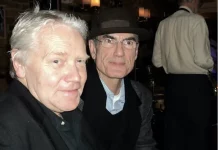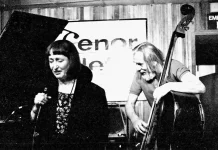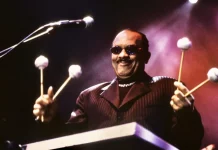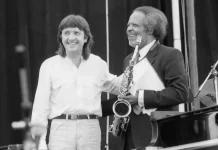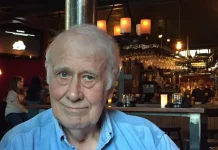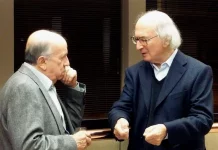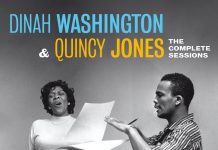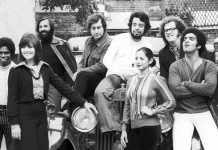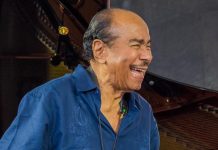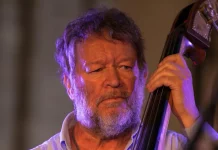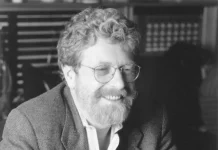One of the most accomplished arranger-composers to emerge during the 1950s, Bill Holman was born in Orange County, Los Angeles on 21 May 1927. André Previn once observed that “Holman was a first rate saxophonist but his true instrument is the orchestra and he plays it with musicianship, honesty and brilliance”.
Beginning on clarinet Holman soon switched to the tenor after hearing Lester Young with Count Basie. He served in the U.S. Navy from 1944 to 1946 and then enrolled at the Westlake College of Music from 1948 to 1951 with the aid of the G.I. bill. He also studied counterpoint privately with Russ Garcia, with particular reference to his book The Professional Arranger And Composer. He joined Charlie Barnet in 1950 in a band that included Eddie Wasserman, Dick Meldonian and Claude Williamson.
It was his good friend Gene Roland who recommended him to Stan Kenton in late 1951. Holman had written a 12-tone blues which he showed to Roland, who said “I think this is what Stan is looking for.” By early 1952 there was a vacancy because Bob Cooper was leaving, so Holman took over on tenor and joined a writing team that included Gerry Mulligan, Bob Graettinger, Pete Rugolo, Johnny Richards and Shorty Rogers.
Mulligan’s writing had a profound influence on Holman – “I loved his charts so much.” His arrangements often reflected Gerry’s contrapuntal approach, prompting this comment from Mulligan: “The first chart I took to a rehearsal was rejected by Stan but the next day Bill Holman brought in an arrangement that sounded more like me than I did!”
One of his earliest charts for the band was Invention For Guitar And Trumpet, which appeared on New Concepts Of Artistry In Rhythm in 1952. It was also heard in the 1955 film Blackboard Jungle, starring Glenn Ford. Bill felt that by 1955 “Stan more or less turned the band over to Al Porcino and Mel Lewis and they set about getting the band to swing”, which they certainly did on Contemporary Concepts that year. It featured Holman’s famous paraphrase of Stompin’ At The Savoy which has 12 bars in the A sections instead of eight and remained in the book for years. The album also included two of his own favourite charts – What’s New and Stella By Starlight. He had by now become chief arranger and continued to write off and on for Kenton until 1977.
When he left Kenton as a player he joined a thriving West Coast jazz scene recording on tenor and occasionally on baritone with Shelly Manne, Shorty Rogers, Stan Levey, Chet Baker, Med Flory, Art Pepper, Jimmy Rowles, Conte Candoli and many more. He co-led a group with Mel Lewis featuring Jack Sheldon and Jimmy Rowles that appeared at the Jazz Cellar in Los Angeles. He also provided outstanding big-band charts for Maynard Ferguson, Billy May, Gerry Mulligan, Woody Herman, Charlie Barnet, Les Brown, Harry James and Terry Gibbs. His own big band recorded The Fabulous Bill Holman (1957), In A Jazz Orbit (1958, with an Andre Previn sleeve-note) and Great Big Band (1960). In the late 50s he said “What I like to capture is a real jazz spirit so that no matter how much is written down, the music should have all the feeling of improvisation.”
In 1960 he received his first Grammy nomination for Peggy Lee’s I’m Gonna Go Fishin’ and he went on to work with many other singers including Mel Tormé, Carmen McRae, Natalie Cole, Anita O’Day, Sarah Vaughan, Ella Fitzgerald, Jackie & Roy, Tony Bennett and Pearl Bailey. He arranged for Manhattan Transfer and the Fifth Dimension and from 1966 he contributed several notable charts to Buddy Rich’s big band, including The Midnight Cowboy Medley from the 1970 Keep The Customer Satisfied album.
In 1975 he formed the Bill Holman Band, a 16-piece ensemble which rehearsed once a week for the next 45 years at the Musicians’ Union Local 47 in Hollywood. I am indebted to my friend Steve Cerra from Santa Ana, California, who has provided an extensive list of musicians who have been involved with the band over the years. It includes Al Porcino, Charlie Mariano, Herb Geller, Carl Saunders, Lanny Morgan, Jeff Hamilton, Jack Sheldon, Pete Christlieb, Bill Perkins (Holman’s oldest friend), Bob Cooper and Frank Rosolino. In a 1999 interview Christlieb told me “There is nobody in the world who can shine Bill Holman’s shoes when it comes to writing for a big band.”
The band regularly appeared at the annual festival organised by the Los Angeles Jazz Institute. It also recorded on five occasions, producing The Bill Holman Band (1987), A View From The Side (1995, which received a Grammy Award for the title track and includes sleeve-note tributes from Manny Albam, Bob Brookmeyer, Ralph Burns, Benny Carter, Quincy Jones, Peggy Lee, Johnny Mandel, Gerry Mulligan, Maria Schneider, Artie Shaw and Gerald Wilson), Brilliant Corners: The Music Of Thelonious Monk (1997, which received a Grammy Award for Straight No Chaser), Live (2005) and Homage (2007).
Holman frequently ran composing and arranging master-classes in the US and Europe. In 2000 the Smithsonian Institute established the Bill Holman Collection, housing scores and memorabilia. In 2010 the National Endowment for the Arts bestowed the NEA Jazz Masters Award on “composer, arranger and tenor saxophonist Bill Holman”. A film Charting Jazz: The Mastery Of Bill Holman is currently in production.
(Bill) Willis Leonard Holman died peacefully of natural causes at his home in the Hollywood Hills, 6 May 2024.


